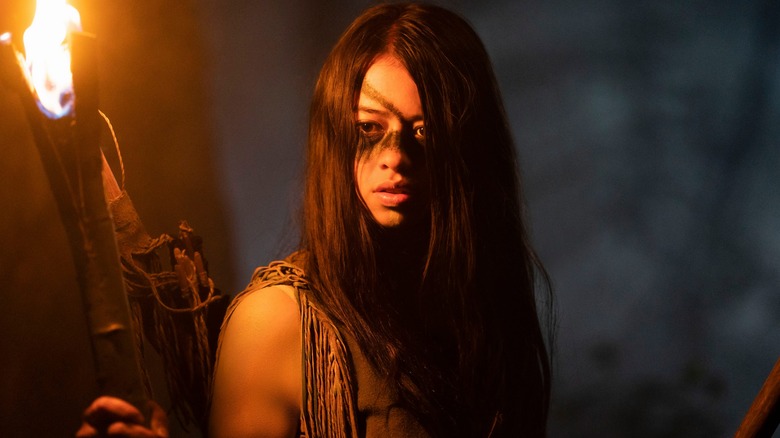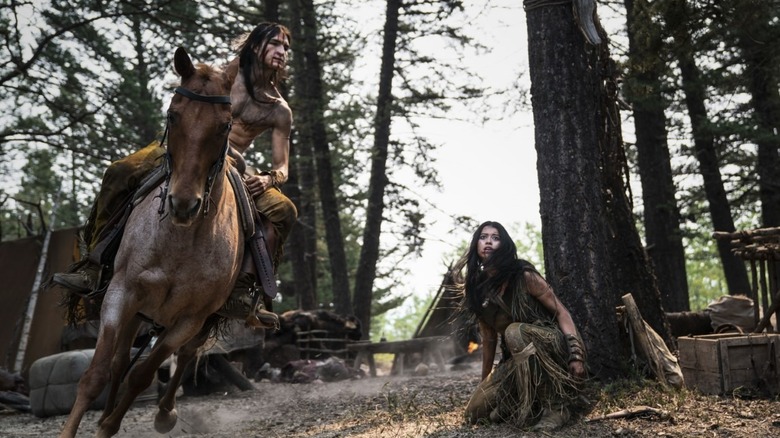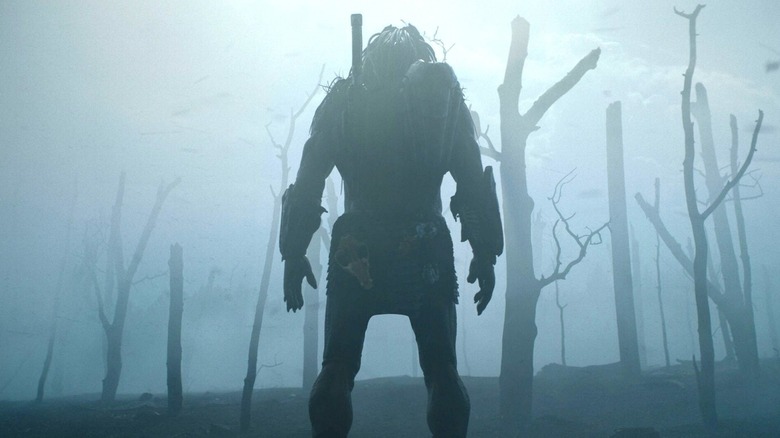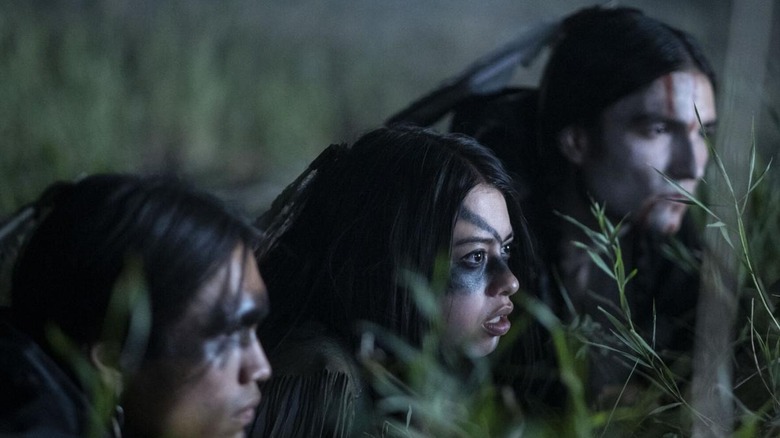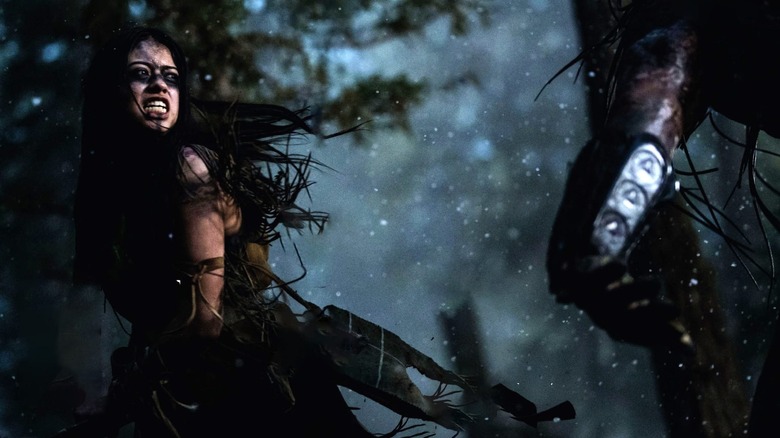Prey Cinematographer Jeff Cutter On The Challenges Of Filming A Predator Movie [Spoiler Interview]
Simplicity is best in the "Predator" franchise. Wisely, director Dan Trachtenberg and his team of artists went back to basics with "Prey." Like the original classic, the prequel is a hunt story, featuring a star performance from Amber Midthunder defined by great strength and vulnerability. Cinematographer Jeff Cutter captures Naru's (Midthunder) journey with both natural beauty and dread.
Cutter previously worked with Trachtenberg on "10 Cloverfield Lane" and "The Boys" pilot. During his early days as a cinematographer, he shot some of the biggest musical artists around, including George Michael and Mick Jagger. Now, with "Prey," Cutter helps ground this franchise in reality by using more natural light and avoiding as much artifice as possible. Recently, Cutter talked to us about his experience of crafting the latest entry in the "Predator" franchise and explained the difficulties of shooting the famous alien.
'Let this beauty speak for itself'
You really feel the beauty of these landscapes. Were you using a lot of natural light making this movie?
The approach that we talked about was to be as ultra-naturalistic as we could be. Not to sound too weird, but to respect nature and to respect the landscapes that we were afforded to shoot in. As opposed to trying to overly stylize things or overly complicate things, let this beauty speak for itself. The less that we could affect it, the less artificial light, I think is just a general approach of not putting anything between the audience and the film. If you start becoming too self-aware of lighting or things that don't feel realistic, then I think you get sucked out of the movie. Ultimately, it was really something that was for contrast — here's the Predator's futuristic technology and weaponry against the primal and barebones nature of Naru's character and her journey.
What about for the nighttime photography? Are the torches usually the main source of light?
When we did the night stuff with the torches, there were a couple things. For the most part, I definitely tried to light them with the torches. The two things we did is for some of the night stuff, because we had other night sequences where there weren't going to be torches — I really wanted torches in blackness, but then the more I thought about it and was thinking about the end fight and these other sequences where there isn't torch light, there has to be some kind of source. At that point, it's obviously going to be moonlight. I wanted to always be hinting at that, but I didn't want big shafts of blue moonlight crashing through the trees.
I tried to just put very soft, low underexposed amounts of blue, and then we had atmosphere always in all our exteriors whenever we could. I was trying to just get that smoke to be slightly lit in the background, so there was a little bit of contrast of the warmth and then the moonlight. And then also, when you got to the strict moonlight scenes, you're not like, "Oh, where'd this all of a sudden come from?"
It goes back to what you were saying earlier about being naturalistic, but with nighttime, you can only be so naturalistic without adding too much artifice, right?
Yeah, it's funny. I think you'll talk to a lot of the cinematographers, and it is that struggle. Night can mean many things to many different people, but yes, as naturalistic as all the day exterior stuff is and can be because you can embrace the daylight and you really can just work with that. You're starting from scratch when it comes to night work. So yes, you end up with softboxes and Condors. You think back to, "Well, what's the motivation and why is everything supposed to be naturalistic and what are you trying to do?"
With digital and film, how have you found that both of them compare when trying to capture both naturalistic beauty and nighttime sequences?
I think you can do the same. You could have done the same thing on film, you can rate film at, and maybe not as much as some of these sensors that can get up to 2,500 and dig in there, but you could take your average 500 stock, you could push it a stop so you could be shooting in 1,000 ISO. You could have done the same thing, but I think digitally, it allows you to do it and it allows you to not be afraid to do it. I think that was always the thing that certainly held me back is the fear that "Oh, this isn't going to read," you know what I mean?
Digital, yes, you can immediately see it. I think that allows you to go, "I don't need a backlight here," or "All I need is let me light up the smoke in the background as opposed to backlighting the whole thing and that'll give me the depth that I need." Digital affords you, I think, to do that because what you see is what you get, and you can really, really push things and push how far you can go. You'll find these beautiful images much quicker than you could on film.
For me, it was always the fear of whether I was underexposing and or is there just too much black in the frame? Now, you look at an image. Some of my favorite images of the people with the torches, I think you might previously on film have feared, "Well, all you're seeing is this tiny little bit." Any number of things. Ultimately, you can sign off really quickly on something that's beautiful and go, "This is great, let's shoot it."
When digital cameras started to dominate movies, there were a lot of issues still be worked on, but do you remember when you first thought, "This is finally working just right"?
I remember shooting a film in 2011. It was right when the ALEXA had just come out and that was the first time where I felt like, "Oh, wow, these are really beautiful images" that weren't lacking that cinematic quality that the previous cameras, the early Sonys. I forget what else had come out before that, maybe the RED was out.
With that yellow tint?
Yeah. For me, it was the first iteration of the ALEXA where I was like, "Oh." Now, having said that, when I got that digital negative into coloring it was like, "Oh." It didn't quite hold up as well, because it was only 2K at that point, I think. It wasn't holding up as well. Still, it was amazing, but I think it was probably not for another few years when ALEXA finally was able to do 2.8K raw and stuff. And then it was like, "Okay, this is kind of there." Then as soon as — essentially when Roger Deakins was like, "Okay, I'm shooting everything on the ALEXA," I was like, "Well, if it's good enough for Roger, it's good enough for everybody else."
'The most difficult sequence in the whole film'
You have some great silhouette shots in this movie. What's the trick to making those shots as evocative as they are?
I remember being with the late, great [cinematographer] Jordan Cronenweth and him talking about "Blade Runner." When you watch that film, it's all his depth. There's very little backlight, it's all created through layering things and light and dark in the depth. Rather than separating characters with the traditional backlight, he would do it with putting the light side of faces against dark backgrounds or dark sides of faces against light backgrounds. It was much more an approach of following those basic, fundamental building blocks of issuing backlight and "Okay, so here's our character. Our choices to see this character are either to light this character against dark, or to not light this character and light the background."
How about capturing the smoke and all elements at play during the "bait" sequence?
That was probably the most difficult sequence in the whole film, in terms of continuity and trying to keep this level of smoke going. I think there were two or four on the back of pickup trucks, these giant smoke machines, just churning out a massive, massive volume of smoke. We were probably 45 minutes outside of Calgary, but there were helicopters coming and checking, making sure that it wasn't some brushfire or something because we had so much smoke coming out.
We had those massive machines and we had the forest that Kara [Lindstrom], our production designer, had built. 250 by 250 ft with about a hundred of these trees that they put up. Scarred, scorched looking trees and we were just pumping, pumping smoke in and using the smoke also to basically blow out the sun because it's supposed to happen early, early morning. We were shooting over the course of eight days from sun up to sun down. We would just have to have so much smoke, and it would just literally blanket the sun.
For the machines, we would have to calculate where the wind was and move these things around. Some shots are more effective than others, because the first day we were definitely struggling and Dan was like, "Did we make a mistake?" We wanted to shoot on stage. We had a whole discussion about that originally with the line producer and then it just became too expensive with set extensions.
There's no fast cutting, and there are also no long takes for the sake of long takes, in the action. The shots have breathing room but a quick intensity. How'd you approach shooting the action in general, especially the "bait" sequence?
So in that whole sequence was previz'd by Third Floor. Dan has worked with them before, we worked with them on the pilot of "The Boys." They're great at not only doing the things that you talk about, but also coming up with really cool ideas. Dan is super collaborative and he welcomes all ideas and it became a roundtable where we would discuss those things and previz it and figure out what works and what doesn't. And then in the process of shooting, I think that sequence in particular, we adhered pretty closely to the previz. We knew what pieces worked and what didn't. Sometimes you stumble into something that doesn't work and you have to solve it on the day.
When Dan and I did "10 Cloverfield Lane," there's a whole action scene at the end. Dan talked about wanting to do a oner and we went back and forth because I didn't really want to do a oner, we talked about it, and then came up with this hybrid thing where we said, "You don't have to do a oner, but that doesn't mean something has to be full of cuts, either." You can take an action and take it as far as you can, when it gets to an obvious place where either you need to cut because you need to see a reaction, or you need to cut because you need a reverse or it's just a technical limitation.
Here, well, you need to cut here because now you want to go to the fur trappers on the tree line or whatever. Let's just keep these things moving, it doesn't have to be either. It doesn't have to be a oner, or it doesn't have to be a bunch of quick cuts. Try to make something continue because the more it continues, the more it does become something where people A, understand what's happening and B, appreciate that it isn't jumbled up and stuff.
'Oh, here we go with the torches again'
Amber is great in this movie. It's so rare when a performance is as exciting as the action in a film. Certain cinematographers say there are certain elements of an actor, their performance, they want to capture and do justice. For you, what qualities of Amber's did you want to highlight?
I think there was a sense of defiance and a sense of self that she exhibited where you felt she was in control of this character and that there was ... anger's not the right word, but that there was something she was trying to prove, and I think Amber definitely channeled that. It was about being sensitive to that, being sensitive to her. I think you want to be sensitive to performances, which is another reason I think also why a naturalistic approach on a lot of projects often make sense.
For example, when we were doing the torches, for a couple wide shots where I wanted just a bit more light on their faces, one of the few times we put little LED strips on the torches. So, they're running up the hill and she's holding the torch. They had to be told exactly how to hold the torch so that the LED strip wouldn't show to the camera, but it would light their face. It's a whole thing and they were all great about it.
When it came to the scenes, I remember Amber saying, "Oh, here we go with the torches again." She was just making a joke, but I said, "No, not here. Here, it's just torches." You can do whatever you want with the torches. Sure, you can give them these notes about how to hold a torch, and it's going to make the image better, but I'm not interfering with performance. In these moments of performance where she's talking to her brother or where they're stalking the mountain lion, when they're doing those things and they have these intense performance scenes, you don't want to get in the way and you don't want that stuff to hinder those performances.
For any of those scenes or when she comes across the snake and the footprint, and when they're taking the injured Comanche warrior back, [we didn't use the LEDs for any of those scenes], because my job is to not get in their way. I try to back off and observe the rehearsals, try to see how I can do my job and when sometimes you need them to do something, if you're always going to an actor and saying, "I need you to do this, I need to do that," it probably gets exhausting. But if you do that sparingly, then I think they respect that and go, "Oh, okay. This is something that he legitimately wants."
So you don't say very often, "Amber, if you're right over here, it's going to cast a great shadow"?
Yeah, try not to do that. You try to find those moments as you're rehearsing or even once the scene has been blocked. Maybe sometimes you'll change something or sometimes you'll fight to have something be shot later in the day. You'll be like, "You know what? Sorry, this just doesn't look good right now. If we wait, this is going to look a lot better." Or if Amber stands here against the fire, then now I can get the lights now wrapping into her other eye, but it's not wrapping too much. It can be just perfect, and you pitch those ideas and you pitch them to Dan. I pitch them to the director. Sometimes you go talk to the actors, but usually, you always have to involve the director as well. Again, you try to minimize that as much as possible.
How about shooting the Predator? How do you light the creature in a way for an audience to fully appreciate the level of detail but also don't show too much?
That's definitely a tricky one. I remember rewatching a bunch of the "Predator" films and other monster films where you've got a character in a suit. Sometimes you look at stuff and go, "Wow, that just looks incredible." And then sometimes you go, "That just doesn't work." It's a balance because we definitely favored shadow, for sure. The suit is definitely much more forgiving at night, and much more forgiving when you can keep it in the dark.
Even in the daytime with the fur trapper sequence in the fog, there it looks amazing. Some of the broad daylight stuff, which is minimal, that was always the intention. We knew the suit wouldn't necessarily stand up to a lot of scrutiny in broad daylight. Some of it is testing in the beginning where you try different things and you look at different colors on the suit colors, soft light, hard light.
When shooting, you learn very quickly the things you can and can't do. For more reflective, kind of the better it looked when it was wet, so those things really helped. And then even in the final color [mix], you start finessing and go, "Oh, it's actually better less brown," or, "It's better when you pull some of the color out of the shadows," or whatever it is that you end up doing. It's all incremental. You take your little whacks at it everywhere you can.
'Those super wide shots were our very wide Sergio Leone Western standoff shots'
There are some great wide shots in this movie, especially when it is two characters facing off. What lenses were you using?
We were using the large format anamorphic. We shot on the ALEXA mini LF, we had a couple of LF minis, and then we shot with the Cooke 1.8 anamorphics, so they were the full frame ones. Our widest lens was maybe a 28, but that equates to about a 12 mil in traditional 35 millimeter spherical terms, so it's about a 12. We didn't use it that much, but those super wide shots were our very wide Sergio Leone Western standoff shots.
When CG will be added to shots later, especially with animals, does it change how you shoot at all?
From my end, not so much. The VFX guys, they take care of so much of that, have references, and occasionally ask us about it. An example is, we learned with the deer hunt which we shot, the less open it ends up being, the better. CG animals are always a tricky thing. Again, it's such a naturalistic and realistic setting and we shot 99% of it outdoors and 1% or less on stage. You want all of that stuff and some beautiful, beautiful locations and you don't want to sully that up with fake-looking CG animals. The less broad daylight, the more you can obscure things or find ways to hide, partially obscure creatures. Most of it's on those guys, it doesn't affect me too much.
How about capturing the Predator's blood? What's the balance between practical and CG there?
A lot of that is definitely is helped out in post because we had issues with — and this has been an ongoing thing for all the entries in the franchise for years and years. The blood is made from those the glow sticks, so that's what they're using and they've found that to be the best stuff. Unfortunately, it's quite corrosive on the suit, the Predator suit, and you can't really put it on human skin. We had a certain, slightly iridescent makeup for Naru, for Amber, and then that gets augmented.
I mean the Predator, yes, they use that stuff on the Predator suit. They just have to use it sparingly and then once it goes on, they wipe it off and clean it off. By the time we got to the end and knowing that this was the end, they were able to be more liberal with the application of it, but it gets very much augmented. Again, I really didn't want to feel like I was trying to do anything and pushing anything too artificial. If I started to light some of that stuff up, if there's a debate, and if I can maybe improve this, but if it's going to make the general photography suffer, then no, then I'm not going to do it.
"Prey" is now available to stream on Hulu.
